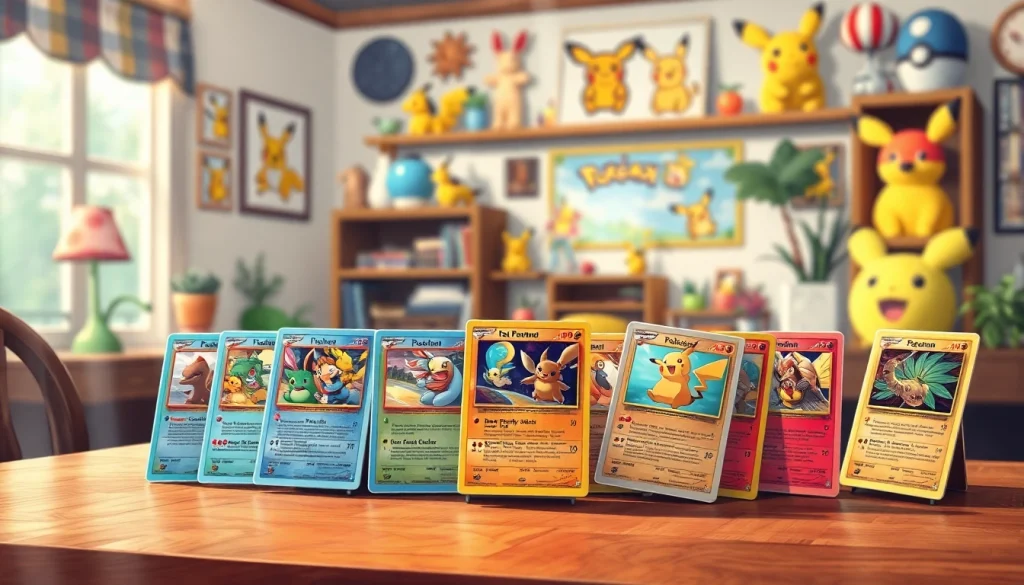The Ultimate Guide to Real Pokemon Cards for Collectors

Understanding Real Pokemon Cards
What Are Real Pokemon Cards?
Real Pokemon cards are officially licensed trading cards produced by The Pokemon Company. These cards are highly sought after by collectors and players alike. The Pokemon Trading Card Game (TCG) features a diverse array of cards that include various Pokémon, abilities, and battle strategies. The cards can be categorized into different types — including basic Pokémon, evolution forms, trainers, and energy cards — each playing a significant role in gameplay. Collectors appreciate these cards not just for their utility in battles but also for their potential value over time.
History and Evolution of the Pokemon Trading Card Game
The Pokemon Trading Card Game was first introduced in Japan in 1996 and quickly gained popularity worldwide. The game has gone through numerous expansions and modifications, reflecting changes in the Pokémon video games and animated series. Collectors are especially interested in earlier editions like the Base Set and holographic variants, which often carry a higher value due to their scarcity and nostalgic appeal. Over the years, the cards’ designs have evolved, incorporating advanced printing techniques and special features such as textured surfaces and foil foils, contributing to their allure among collectors.
The Value of Collecting Real Pokemon Cards
The value of collecting real Pokémon cards can vary significantly based on several factors: rarity, condition, demand, and uniqueness. Over the past few years, the market for Pokémon cards has surged, with rare cards fetching thousands of dollars at auctions. For instance, a first edition Charizard card has been known to sell for over $200,000 if graded highly. Additionally, collectors often find joy in completing sets and obtaining cards with unique artwork or limited editions. The thrill of a successful collection can be a rewarding personal experience, emphasizing the combination of nostalgia and investment potential in real Pokémon cards.
Identifying Real vs. Fake Pokemon Cards
Key Characteristics of Authentic Pokemon Cards
Distinguishing real Pokémon cards from counterfeits is crucial for collectors. Authentic cards possess certain key characteristics that fakes typically lack:
- Weight and Thickness: Real cards have a specific weight and thickness. They usually weigh around 1.8 grams and are made from a high-quality cardboard, giving them a solid feel.
- Print Quality: The printing process for authentic cards is high-quality, showcasing sharp details, vibrant colors, and crisp line work. Blur or misalignment can indicate a fake card.
- Light Test: When held up to a light source, real Pokémon cards will allow minimal light to pass through, while fakes often appear almost transparent.
Common Signs of Counterfeit Pokemon Cards
Several signs can indicate whether a Pokémon card is counterfeit. These include:
- Poor Print Quality: If the card appears faded or the colors lack vibrancy, it could be a fake.
- Incorrect Font or Typos: Counterfeit cards often feature spelling errors or font inconsistencies.
- Excessive Flexibility: Genuine Pokémon cards have a certain level of rigidity; fake cards can feel overly flexible and lack the appropriate bounce when bent.
- Off-Centered Images: If the image is not properly centered or is cut poorly along the edges, the card may not be authentic.
Resources for Verification and Authentication
To ensure you’re dealing with real Pokémon cards, utilize available resources:
- Online Guides and Communities: Websites dedicated to Pokémon card collecting often share insights on spotting fakes. Communities, such as subreddit forums, also provide firsthand experiences and advice.
- Professional Grading Services: Companies like PSA (Professional Sports Authenticator) and Beckett offer grading services that authenticate and assign a value to your cards. Their grading can enhance the resale value.
- Mobile Apps: Some apps, such as those developed specifically for Pokémon enthusiasts, allow users to compare their cards with authenticated images and check if they meet expected standards.
Where to Buy Real Pokemon Cards
Top Online Retailers for Authentic Pokemon Cards
When searching to buy authentic Pokémon cards, several reputable online retailers stand out:
- Pokemon TCG – The official Pokémon TCG site provides a list of authorized sellers and stores where you can purchase authentic products.
- Cardmarket: Europe’s largest marketplace for trading cards boasts a vast collection of singles and booster packs at competitive prices.
- Amazon: While caution is advised, many reputable sellers on Amazon offer verified authentic Pokémon cards, including booster packs and singles.
Local Stores and Game Shops that Sell Real Cards
In addition to online platforms, many local game shops and hobby stores sell real Pokémon cards. These stores often provide a community setting for buyers to interact, trade, and discuss strategies. Engaging with your local game store can be instrumental as they often hold events or tournaments. You can also inquire about upcoming releases or promotional events that can help you expand your collection.
Tips for Safe Online Shopping for Pokemon Cards
When purchasing Pokémon cards online, following these tips can enhance safety and satisfaction:
- Check Seller Ratings: Ensure that the seller has positive reviews and a strong track record of delivering authentic products.
- Understand Return Policies: Familiarize yourself with the return options in case the received product does not meet your expectations.
- Look for Quality Photos: Sellers should provide high-resolution images of the card, showcasing both the front and back for authenticity verification.
Card Grading and Collecting Best Practices
Understanding Card Grading and Its Importance
Card grading is an essential aspect for serious collectors. Grading assesses a card’s condition based on specific criteria, including surface quality, centering, edges, and corners. Cards graded by recognized services receive a number on a scale from 1 to 10, with 10 being gem mint. A higher grade typically translates to higher resale value. Understanding this system allows collectors to make informed decisions when acquiring or selling cards. This can be particularly relevant during negotiations for rare cards, where the grade can significantly influence pricing.
How to Protect and Display Your Real Pokemon Cards
Protecting your real Pokémon cards is critical to maintaining their value. Here are some tips for safeguarding your collection:
- Use Sleeves: Store cards in protective sleeves and top loaders for additional protection against wear and tear.
- Maintain Optimal Conditions: Keep your cards in a cool, dry place to avoid moisture damage and direct sunlight exposure, which can fade colors.
- Display Wisely: If displaying cards, consider using UV-protective cases to prevent sunlight damage while allowing for clear visibility.
Insurance and Value Preservation for Rare Card Collections
For collectors with significant investments, insuring rare cards can provide peace of mind. Several specialized insurance companies offer policies tailored for collectible items. It’s important to document your collection with detailed descriptions and photographs for valuation purposes. Keep records of card grades from professional grading services, as these documents can help in the event of theft or damage claims.
Advanced Collecting Strategies
Collecting Real Pokemon Cards: Strategies for Success
Effective strategies can enhance your success in the Pokémon card collecting realm:
- Focus on Completeness: Consider aiming to complete focused sets (like a specific series or type) rather than haphazardly acquiring cards. This can lead to better appreciation and increased values over time.
- Stay Updated on Trends: Follow market trends and changes in card values. Engaging with online communities and forums can provide insights into which cards might appreciate.
- Attend Events: Participating in local and regional card events can help you connect with other collectors. Networking can lead to valuable trade opportunities and insights into game play.
Networking with Other Collectors and Communities
Building a strong network is a key aspect of successful collecting:
- Join Online Forums: Websites like Reddit, Discord, and specialized Pokémon forums provide platforms to connect with like-minded collectors.
- Utilize Social Media: Platforms such as Instagram and Facebook have groups dedicated to Pokémon card collecting where users post trades, latest finds, and tips.
- Create Local Collecting Groups: Consider starting a local group that meets regularly to trade cards and discuss strategies, helping foster a sense of community.
Staying Informed: Resources for Collectors
To maintain a robust knowledge of the Pokémon card market and trends, utilize various resources:
- Collector Magazines: Subscribing to magazines and publications focused on trading cards can provide insights into pricing, market trends, and interviews with collectors.
- YouTube Channels: Many collectors share their experiences, tips, and insights through video content, which can be an engaging way to learn.
- The Pokémon Company Updates: Regularly check for official updates on new releases and tournaments hosted by The Pokémon Company to stay informed about trends.




